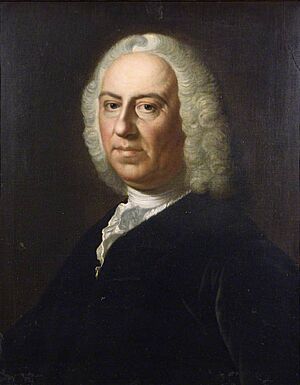Francesco Geminiani facts for kids
Francesco Xaverio Geminiani (born in 1687, died in 1762) was a talented Italian violin player, composer (someone who writes music), and music teacher. Even though he is not as well-known today, people in his time thought he was as great as famous composers like Handel and Corelli.
Life of a Musician
Francesco Geminiani was born in Lucca, Italy. He learned music from Alessandro Scarlatti, a well-known composer. He also studied the violin with Carlo Ambrogio Lonati and later with Arcangelo Corelli, who was a very important violinist and composer.
In 1707, Francesco took his father's place in the Cappella Palatina in Lucca. Later, in 1711, he became the leader of the opera orchestra in Naples. This gave him many chances to work with Alessandro Scarlatti.
In 1714, Geminiani moved to London, England. He was already known as an amazing violin player. He quickly became popular and found people who supported his music, like William Capel, 3rd Earl of Essex. In 1715, Geminiani even played his violin music for King George I, with Handel playing the keyboard alongside him!
Francesco Geminiani earned money by teaching music and writing his own pieces. He also loved collecting art, but this sometimes caused him money problems. Many of his students became successful musicians, including Charles Avison and Matthew Dubourg.
After spending some time in Paris, France, he returned to England in 1755. In 1761, while he was in Dublin, Ireland, a servant stole a music paper he had worked on for a long time. People say this made him very upset and might have made him sick. He died and was first buried in Dublin. Later, his body was moved back to his hometown of Lucca, Italy, and buried in the church of San Francesco, Lucca.
People said he was an excellent violinist. Another famous musician, Tartini, even called him Il Furibondo, which means "the Madman," because of how expressive and lively his playing was.
Geminiani's Music and Books
Geminiani wrote many pieces of music. His most famous works are three sets of concerti grossi. These are like special concerts for a small group of solo instruments and a larger orchestra. In his concertos, he included the viola as one of the solo instruments, which was quite new at the time. This made his concertos sound like they were for a string quartet (a group of four string instruments).
His music was very detailed and had many layers of sound, which was popular in London. He also took some of his teacher Corelli's music and rewrote it as concerti grossi.
One of Geminiani's most important works is a book he published in 1751 called Art of Playing on the Violin. This book is a fantastic guide to how people played the violin in the 1700s. It has 24 exercises and clear instructions on how to hold the bow, play trills (a quick back-and-forth between two notes), and move your fingers on the violin. This book is still very helpful for people who study old music today!
He also wrote another interesting book called Guida harmonica (around 1752). This book is like an encyclopedia of musical patterns for composers. It has over 2,000 patterns and shows how different musical ideas can connect.
Geminiani also published other works, including solo pieces for the violin, violin trios (music for three violins), and books on how to play the harpsichord, organ, and guitar.
What People Thought of His Music
Geminiani's music is known for being very imaginative, expressive, and warm. It showed a lot of feeling. Some people also felt that his music, while beautiful, sometimes lacked a bit of strict structure or was not fully developed in every part.
See also
In Spanish: Francesco Geminiani para niños


